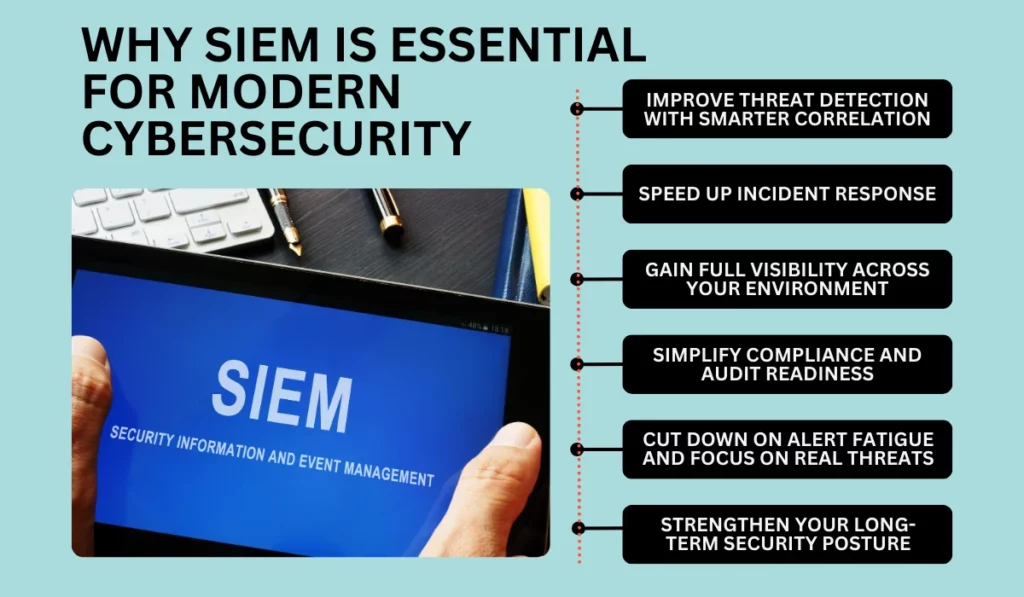Cybersecurity
How to Mitigate the Risks of BYOD Policies
Mark Lukehart

At 5:00 a.m. on February 21, 2024, healthcare operations across the U.S. came to a halt. A ransomware attack on Change Healthcare froze insurance claims, delayed prescriptions, and forced hospitals into manual mode. UnitedHealth Group, the company’s parent, expects total damages to exceed $2.3 billion. In addition to financial loss, the breach created massive operational disruption and long-term trust issues.
Cyberattacks like this are becoming increasingly common. As businesses digitize more data, applications, and infrastructure, cyber threats grow in volume and complexity. Siloed tools are no longer enough. Without centralized security monitoring, companies struggle to detect potential threats, correlate event data, or respond to fast-moving security incidents.
SIEM helps solve this problem. Short for Security Information and Event Management, SIEM tools ingest logs from across your network (firewalls, endpoints, cloud platforms) and use event correlation and threat intelligence to detect real-time anomalies. They act like your cybersecurity control tower, scanning, alerting, and helping you act before damage is done.
In this guide, you’ll learn what SIEM is, how it works, the benefits of SIEM platforms, and how managed services like Parachute Technology can help you deploy and maintain an effective solution without overloading your team.
SIEM stands for Security Information and Event Management, but that mouthful fuses two functions:
SIM’s historical insight and SEM’s immediacy give SIEM its power. ResearchGate notes: “SIEMs constitute the central platform of modern security operations centers as they gather events from multiple sensors (IDS, antivirus, firewalls), correlate them, and deliver synthetic views of the alerts for threat handling and reporting.”
Behind every effective SIEM solution is a series of well-orchestrated steps that transform raw log data into real-time insight. Modern SIEM platforms are designed to centralize, streamline, and strengthen your response to potential threats, from collecting event data across your entire infrastructure to triggering alerts and supporting compliance.
Here’s how it all comes together.

The demand for SIEM solutions is accelerating. The global Security Information and Event Management (SIEM) market is projected to reach $9.49 billion by 2030, growing at a CAGR of 10.16% from 2024 onward (QKS Group).
As cyber threats become more advanced and compliance requirements more stringent, organizations turn to SIEM to centralize visibility, reduce response times, and harden their overall network security posture. Here’s why it’s becoming mission-critical.
A modern SIEM solution combines log data from firewalls, cloud apps, endpoints, and identity tools. Running event correlation and layering in threat intelligence identifies patterns that traditional tools miss. This lets your team detect advanced cyber threats, including malware, suspicious user behavior, and multi-stage attacks before they escalate.
Fast response starts with having the proper context. SIEM tools centralize event data so your security team doesn’t waste time searching across systems. Alerts are enriched with details that help analysts move quickly from detection to containment. Many SIEM platforms also integrate with security orchestration, automation, and response systems, enabling faster remediation.
Whether running on on-premises infrastructure, in the cloud, or a hybrid model, a SIEM platform gives you unified visibility across all of it. That means fewer blind spots and better monitoring of potential threats and vulnerabilities, all from a single dashboard.
A SIEM makes meeting compliance requirements like HIPAA, PCI DSS, or GDPR easier. Built-in compliance reporting, log management, and data aggregation help you maintain audit trails and respond to requests without hours of manual effort.
A well-tuned SIEM filters out the noise so your team can focus on what matters. Applying behavior analytics and machine learning improves the accuracy of security alerts, reduces false positives, and helps analysts stay productive instead of overwhelmed.
SIEM isn’t just about reacting to today’s security incidents. It also helps you identify gaps in your defenses over time. Analyzing historical data can uncover recurring security issues, fix weak points, and improve defenses.
Unsurprisingly, 85 % of organizations are moving or have moved their SIEM to the cloud for even greater scalability and coverage.
Choosing the right SIEM solution improves visibility, response time, and operational efficiency. Whether you’re a growing business or managing a complex hybrid environment, the right SIEM tools can streamline workflows, support compliance, and strengthen your long-term network security strategy.
Here are the key advantages of a SIEM system:
While a SIEM solution can dramatically improve your security posture, getting it right takes planning, expertise, and ongoing management. Here are the most common obstacles teams run into when deploying and maintaining SIEM tools:
SIEM platforms don’t work well out of the box. Default correlation rules often generate too many irrelevant alerts or miss critical security threats altogether. You’ll need to tailor your SIEM to your infrastructure and threats to get useful alerts. This requires time and an in-depth understanding of your event data sources.
A midsize company can generate billions of daily logs across endpoints, firewalls, servers, and SaaS platforms. Processing that much log data strains storage, increases costs, and can create performance issues, especially for on-premises deployments. Without filtering and smart data aggregation, your SIEM may store more noise than insight.
When rules are too broad or data is incomplete, the system can trigger constant alerts that distract your team from real security incidents. This leads to alert fatigue, missed threats, and wasted time. False positives are a major pain point in poorly managed SIEM tools.
To truly benefit from a SIEM solution, you need professionals who understand threat intelligence, event correlation, and how to interpret alerts in context. Unfortunately, there’s a widespread shortage of cybersecurity talent, particularly for roles like SIEM tuning, threat hunting, and incident response. Many organizations don’t have the in-house staff to run a SIEM effectively.
SIEM implementation isn’t cheap. You’ll need to invest in licensing, hardware or cloud infrastructure, and potentially third-party security services. Hidden costs like training, tuning, and day-to-day management also exist. Without a clear strategy, costs can quickly outweigh the benefits. This is why outsourcing SIEM management to a Managed Service Provider like Parachute can save you many of these initial and ongoing costs.
Not every business has the same security requirements, but certain risk factors make adopting a SIEM solution a smart investment. If you’re weighing whether to implement SIEM or invest in a managed SIEM service, here are five key considerations:
A SIEM provides essential visibility if your environment includes a mix of on-premises, cloud, and remote endpoints. The more distributed your systems, the harder it becomes to detect threats without centralized network security monitoring and event correlation. A SIEM brings all that data together, so your team isn’t flying blind.
Do you handle sensitive data like PII, PHI, payment information, or proprietary intellectual property? If so, the stakes are higher. A SIEM helps protect that data by monitoring for insider threats, failed access attempts, and unusual activity that other tools may overlook.
Industries governed by HIPAA, PCI DSS, or other frameworks often require centralized log management, audit trails, and real-time security alerts. A SIEM supports ongoing compliance reporting and helps you meet those requirements without manual tracking.
Do you have in-house security staff capable of managing alerts around the clock? If not, a managed SIEM, especially when paired with XDR (Extended Detection and Response) or security orchestration, automation, and response tools, can offer around-the-clock protection without hiring a full team.
The cost of a breach continues to climb. A well-implemented SIEM platform helps detect potential threats early, contain damage, and avoid costly downtime. It’s an investment in resilience, not just a security tool.
If these scenarios sound familiar, a SIEM is essential to protect your organization from today’s advanced cyber threats.
Parachute handles the heavy lifting of SIEM deployment and day‑to‑day operations. Our certified security analysts design, implement, and continuously tune your SIEM, on‑prem or in the cloud, so you get actionable alerts instead of log noise.
Every organization’s risk profile is different. We tailor correlation rules, dashboards, retention policies, and compliance mappings to fit your industry, whether you’re a healthcare clinic juggling HIPAA audits or a fintech startup chasing PCI DSS compliance.
Our SOC monitors your environment 24/7/365, harnessing advanced analytics and threat‑intelligence feeds. When alerts fire, we investigate within minutes, contain threats, and guide your team through remediation, minimizing downtime and reputational damage.
When you choose Parachute Technology to manage your SIEM solution, you get a partner that helps reduce complexity and deliver meaningful outcomes.
Managing SIEM tools internally takes time, training, and constant attention. We handle configuration, tuning, and daily operations, so your team can focus on strategic initiatives instead of chasing security alerts or troubleshooting event correlation issues.
Hiring and retaining skilled professionals for threat intelligence, log data analysis, and incident response is expensive and time-consuming. With Parachute, you can access a team of certified experts without the cost of staffing a complete Security Operations Center (SOC) in-house.
Our team deploys SIEM platforms using proven frameworks and tailored use cases. Whether you’re monitoring for malware, tracking potential threats, or addressing known vulnerabilities, we use best-practice playbooks to help you strengthen defenses quickly and effectively.
Compliance isn’t a once-a-year task. We help you meet ongoing compliance requirements with up-to-date compliance reporting, automated data aggregation, and audit-ready documentation. You’ll be ready for inspections and regulations without scrambling at the last minute.
With Parachute, you gain the benefits of SIEM without the burden. From cloud to on-premises environments, we help you streamline your security operations and stay ahead of evolving cyber threats.
If your business handles sensitive data, operates under strict compliance regulations, or simply can’t afford downtime, a SIEM solution isn’t optional—it’s your front line of defense. However, configuring and managing SIEM tools, analyzing log data, and triaging security incidents in real time takes resources that most growing teams don’t have.
That’s where Parachute delivers real value. Our managed SIEM platform gives you complete visibility across your environment, immediate insight into potential threats, and ongoing compliance reporting—without adding operational drag. You get 24/7 security monitoring, expert support, and a solution that evolves with your business. Whether managing insider threats, strengthening network security, or preparing for your next audit, we help you stay protected and focused on scaling.
Want to learn more about how Parachute can streamline your security?
Visit our homepage to learn more about our full suite of security services.
Or book your free SIEM demo today and see how we transform your event data into real-time, actionable defense.
Let us help you secure your business, so you can focus on growth, not alerts.